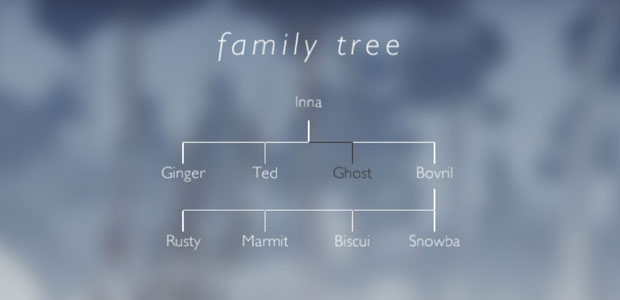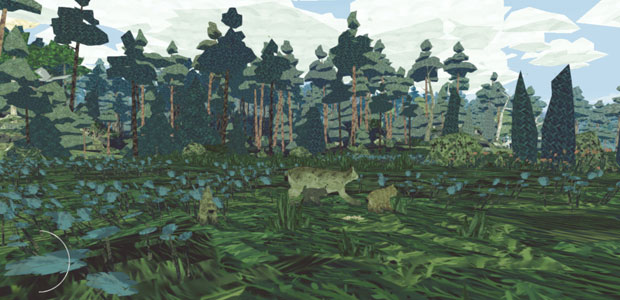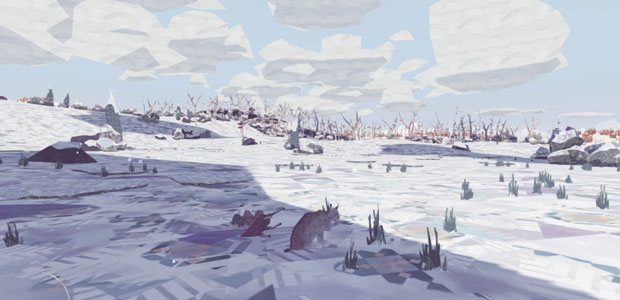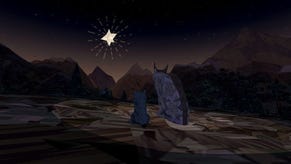Wot I Think: Shelter 2
The lynx effect
Shelter 2 [official site] is Might & Delight's sequel to 2013's badger cub parenting game, Shelter. You play a mother lynx raising a brood of four cubs to adulthood, keeping them safe and fed while roaming the wilderness in search of glowing doodads. Here's wot I think.
I played the original Shelter and found quite a pretty but linear game. I shepherded my badger cub brood through various trials, avoided predators (mostly), skirted forest fires (except for when I decided to let my cubs catch fire to teach them a lesson) and shoved at least two of them into adulthood.
I was surprised to read of other people's emotional investment in the lives of these badgers. or the pressure they put themselves under to keep them alive, because my experience of Shelter was that it became a numbers game pretty fast. The demands of the cubs and their inability to avoid danger by themselves engendered frustration rather than any sense of parental responsibility. It was a noisy escort mission and success was reaching the end with at least one of them still alive.
And so we skip forward to Shelter 2. Lynxes have replaced the badgers and the world is more of a sprawling thing, letting you roam rather than funnelling you through a series of vignettes. In that world are different areas which change according to the seasons and are peppered with lots of little collectibles to find.
The game opens with the pregnant mother lynx evading wolves. It teaches you the basics of running and jumping, then uses glowing stars to guide you across a grassy area to a den where she can give birth. The first difference between Shelter and Shelter 2 is that you can name your cubs in-game. This lot end up called Ghost, Ted, Ginger and Bovril. Those names then show up in a family tree on the main menu and any cubs who survive into adulthood can be playable characters later (if you sit to the very end of the credits and don't quit out thinking the blurry screen and lack of any more words means you're quite done). So I guess you give birth to entirely female litters of one white, one beige, one dark brown and one ginger cub forever.
Bovril survived my first playthrough and I set her up with her own litter but, because of the character limits on the nami,ng her cubs are now called Biscui, Snowba, Marmit and Rusty. That might sound like an insignificant problem but the lack of difference between the litters each time (both in terms of colour and number) intruded on the idea that there was a developing lineage of different animals, and the six character limit made it hard to name the cubs as I wanted and to even begin investing in them as a family.
Starting out you learn to catch rabbits to bring back to your babies. You can generally see them pretty well but if you're struggling you can right click to use Lynx Vision (smell) which shows prey as red silhouettes on a monochrome landscape for a few seconds. You can also use that right click to show icons representing different landmarks so you never get lost. I did occasionally lose sight of the cubs though as they can get overwhelmed by the patchwork of patterns provided by the environment.
Running across the maps to new landmarks or to catch prey uses up energy so you have to ration your bursts of speed. You'll refill the energy meter either while walking or – far faster – by stealing one of the rabbit snacks for yourself. I think this is supposed to introduce the idea of needing to provide for yourself but it's such a simple system you don't really need to use it except to avoid waiting for the meter to recharge. I also found it slightly odd that the cubs – even at their tiniest – can catch up with you after a few seconds when you've been bounding across the field.
From that point onward it's a matter of feeding the cubs a diet of rabbits, frogs and deer while avoiding harm. But where the original game showcased various different types of harm (seen and unseen) that could befall baby badgers, here the threats appear to be wolves (which I only encountered once in the whole of that first playthrough) and something else which might have been wolves, and which killed a cub behind me while we were out in what seemed to be the game's only real nightfall. At one point I stood my three remaining cubs directly by the wolves and waited for a few seconds before running away. I figured the experiment would kill one cub at the most, leaving me with two but we all survived fine.
Other than that one loss early on the babies stayed near me, ate what I gave them and gradually grew, even starting to find prey of their own. That was a really neat touch but given they hadn't felt particularly vulnerable and helpless in the first place it lost some of its impact. There were no real hardships to deal with as I played and thus no real sense of purpose beyond wandering the world.
I'm assuming that's why the collectibles exist – to give you something to do. You'll see them glowing on the ground or on rocks from time to time, and you can pick them up by walking over them. But as far as I could tell there's no way to find them beyond wandering about. Your sense of smell doesn't highlight them and they don't appear to be marked on the map you gradually build up as you move through areas. As a result each feather and twig was just something I found on the ground as I roamed and without a way of telling what I'd already found where, or which areas might benefit from more exploring it wasn't a system which particularly incentivised moving around.
Shelter had its limitations, but it did at least have a sense of pressure, of predators waiting in the wings. In Shelter 2 I didn't seem to need to do much at all to keep the cubs safe. It freed me up a bit to explore the beautiful landscape but beyond collecting twigs, rocks and the skulls from our meals, and observing occasional seasonal shifts, there wasn't much out there to reward the trip. The family tree idea of playing as successive offspring sounded interesting but the reality left me with a second family identical to the original one except in name.
Shelter 2 has a memorable visual identity and a considered soundtrack, but in terms of survival and a rewarding exploration of the space there's just not much there.











